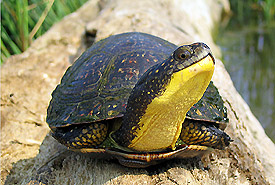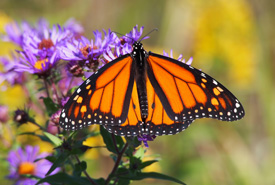MapleCross Coastline Reserve

Blanding's turtle, Frontenac Arch Natural Area, Ontario (Photo by Ryan M. Bolton)
Rare piece of Prince Edward County’s undeveloped shoreline
The MapleCross Coastline Reserve is a collection of undeveloped shoreline, coastal wetland, forest, alvar and grassland habitats. This conservation success was made possible thanks in part to generous match funding from the MapleCross Fund.
The property contains 16 hectares (40 acres) of rare costal wetland — part of the Provincially Significant South Bay Coastal Wetland — that provides a buffer against local flooding as well as habitat for migratory birds, turtles, frogs and fish.
The property is located in the Prince Edward County South Shore Important Bird and Biodiversity Area. The site provides vital stopover habitat for a wide variety of migratory birds. The surrounding area is also home to a variety of resident and migratory bat species, such as endangered little brown myotis, along with big brown bat, hoary bat, migratory silver-haired bat and eastern red bat.
The latest in a series of new protected areas on the south coast of Prince Edward County, the MapleCross Coastline Reserve adds to a network of conservation lands, which includes the:
- 560-hectare (1,400-acre) Prince Edward Point National Wildlife Area, managed by Environment and Climate Change Canada’s Canadian Wildlife Service;
- 198-hectare (490-acre) Miller Family Nature Reserve, owned and stewarded by HPELT;
- 95-hectare (234-acre) Ducks Unlimited Canada property at Gravelly Point;
- 31-hectare (76-acre) NCC Hudgin-Rose property; and
- 15-hectares (38-acre) Mark Bass Nature Reserve.
Prince Edward County South Shore

Monarch (Photo by NCC)
The South Shore peninsula of Prince Edward County has exceptional natural heritage value due to the habitats and species it supports. It is designated as a globally significant Important Bird and Biodiversity Area. IBAs are areas that have been identified as globally important for bird conservation using internationally agreed-upon scientific criteria.
The south shore of the IBA encompasses about 30 kilometres of shoreline. It is the only lengthy, undeveloped strip of shoreline remaining in Prince Edward County — indeed, one of the few shorelines of Lake Ontario that has remained undeveloped.
The popularity of Prince Edward County has grown in recent years, and opportunities to acquire undeveloped lands in a network such as this are becoming increasingly rare. NCC, HPELT and our other partners have a rare chance to protect this important mosaic of habitats before it’s too late. But we need to act fast.
The Ostrander Point conservation project is just east of the HPELT Miller Family Nature Reserve, owned and stewarded by HPELT, and protected with financial assistance from NCC. NCC and HPELT are committed to working together to protect and care for lands on the south shore as part of the Point Petre to Prince Edward Point conservation project.
Eastern Lake Ontario coast — a priority for conservation
NCC is actively working to help conserve priority lands in and around the Lake Ontario coast, stretching from Brighton and Presqu’ile Provincial Park to just west of
Gananoque, and south to include Prince Edward County and associated coastal islands.
This scenic and historic landscape contains a rich mosaic of coastal wetlands, forests, streams, sand beaches and dunes, islands and alvars. It includes world-class coastline and provides critical habitat for grassland and migratory birds. The area is home to a multitude of plant and animal species, many of which are provincially, nationally and globally rare.




